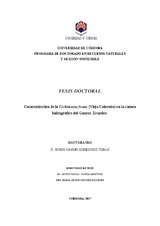Mostrar el registro sencillo del ítem
Caracterización de la Cichlasoma festae (Vieja Colorada) en la cuenca hidrográfica del Guayas. Ecuador
| dc.contributor.advisor | García Martínez, Antón Rafael | |
| dc.contributor.advisor | Angón Sánchez de Pedro, Elena | |
| dc.contributor.author | Rodríguez Tobar, Jorge Magno | |
| dc.date.accessioned | 2017-07-12T07:29:29Z | |
| dc.date.available | 2017-07-12T07:29:29Z | |
| dc.date.issued | 2017 | |
| dc.identifier.uri | http://hdl.handle.net/10396/14921 | |
| dc.description.abstract | Ecuador se considera la capital pesquera del Pacífico tropical sur-oriental con más de 900 especies nativas. Cichlasoma festae representa una importante especie de agua dulce de gran uso local. Por lo tanto, en este estudio, nuestro objetivo fue caracterizar esta especie de peces durante su primera etapa de crecimiento (alevines y juveniles). La investigación contemplo diferentes experiencias; Un grupo orientadas a mejorar el conocimiento de las condiciones de cría y del hábitat de la Vieja Colorada para intentar posteriormente reproducir las condiciones en cautividad. Estas contemplan las condiciones de cría de alevines y animales juveniles en situaciones de confinamiento; la densidad de cría; la utilización de dietas y alimentación con concentrado y finalmente el manejo de los reproductores para la obtención de alevines. En etas experiencias se utilizan fundamentalmente sistemas de recambio de agua y también de recirculación con oxigenación. En una segunda parte se determina la curva de crecimiento y la asociación entres las variables alométricas. Este estudio tuvo una duración de 25 semanas, Se midieron los parámetros biométricos individuales longitud total (L), ancho corporal (BW) y profundidad corporal (BD) de 90 juveniles de C. festae. El crecimiento se determinó utilizando modelos de regresión biológicos no lineales. La longitud media estándar varió entre 6.30 cm y 12.25 cm y el peso promedio varió entre 4.99 y 35.71 g. La relación longitud-peso se ajustó a la ecuación , y la especie presentó crecimiento alométrico negativo. Finalmente, el mejor ajuste para el crecimiento de C. festae fue el modelo de Von Bertalanffy donde = 19.758 cm, k = 0.028 cm week-1 and = -14.463 week-1. Concluimos que el registro de crecimiento de la longitud podría estar asociado a la fotogrametría como una gran herramienta para el desarrollo de una producción pesquera sostenible y segura. Este estudio constituye una valiosa contribución al conocimiento de los recursos nativos piscícolas tropicales continentales en Ecuador. Un avance en la caracterización productiva de la Cichlasoma festae, y un primer paso para su conservación y valoración, así como para la preparación de propuestas para el desarrollo rural sostenible y la formulación de planes para una gestión pesquera ambientalmente responsable. | es_ES |
| dc.description.abstract | Ecuador is considered the fishing capital of the south-eastern tropical Pacific with more than 900 native species. Cichlasoma festae represents an important freshwater species of great local use. Thus, in this study our objective was characterize this species during first stage of growth (fry and juveniles). The research contemplated different experiences, a group of these were oriented to improve the knowledge of the breeding conditions and the habitat of Vieja Colorada and later to reproduce the conditions in captivity. In addition, they contemplate the rearing conditions of fry and juvenile animals in situations of confinement; breeding stock; use of diets and feed with concentrate and finally the management of the breeders to obtain fry. In these experiments, water exchange and recirculation systems with oxygenation were used. In a second step, the growth models were determined the growth model and relationship between allometric variables. The study lasted 25 weeks and the individual biometric parameters total length (L), body width (BW) and body depth (BD) of 90 juveniles of Cichlasoma festae were measured. Growth was determined using nonlinear biological regression models. The average standard length varied between 6.30 cm and 12.25 cm and the average weight varied between 4.99 and 35.71 g. The lengthweight relationship was best fit by the equation , and the species presented negative allometric growth. Finally, the best fit for the growth of C. festae was the Von Bertalanffy’s model where = 19.758 cm, k = 0.028 cm week-1 and = -14.463 week-1. We conclude that the record of length growth could be associated with photogrammetry as a tool for the development of a sustainable and safe fish production. This study constitutes a valuable contribution to the knowledge of native tropical fish resources in Ecuador. The productive characterization of the Cichlasoma festae is a first step for its conservation and valuation, as well as for the preparation of proposals for sustainable rural development and the formulation of plans for an environmentally responsible fishing management. | es_ES |
| dc.format.mimetype | application/pdf | es_ES |
| dc.language.iso | spa | es_ES |
| dc.publisher | Universidad de Córdoba, UCOPress | es_ES |
| dc.rights | https://creativecommons.org/licenses/by-nc-nd/4.0/ | es_ES |
| dc.subject | Piscicultura | es_ES |
| dc.subject | Peces de agua dulce | es_ES |
| dc.subject | Peces - Crecimiento | es_ES |
| dc.subject | Vieja Colorada | es_ES |
| dc.subject | Cichlasoma festae | es_ES |
| dc.subject | Especies nativas tropicales | es_ES |
| dc.subject | Hábitat | es_ES |
| dc.subject | Condiciones de cría | es_ES |
| dc.subject | Alometría | es_ES |
| dc.subject | Pesca sostenible | es_ES |
| dc.subject | Cuenca Hidrográfica del Guayas | es_ES |
| dc.subject | Los Ríos (Ecuador) | es_ES |
| dc.title | Caracterización de la Cichlasoma festae (Vieja Colorada) en la cuenca hidrográfica del Guayas. Ecuador | es_ES |
| dc.type | info:eu-repo/semantics/doctoralThesis | es_ES |
| dc.rights.accessRights | info:eu-repo/semantics/openAccess | es_ES |

